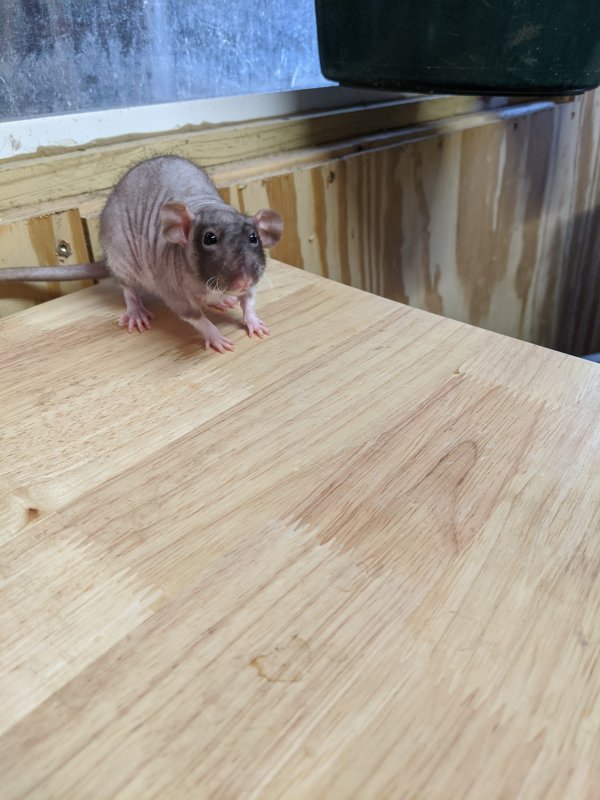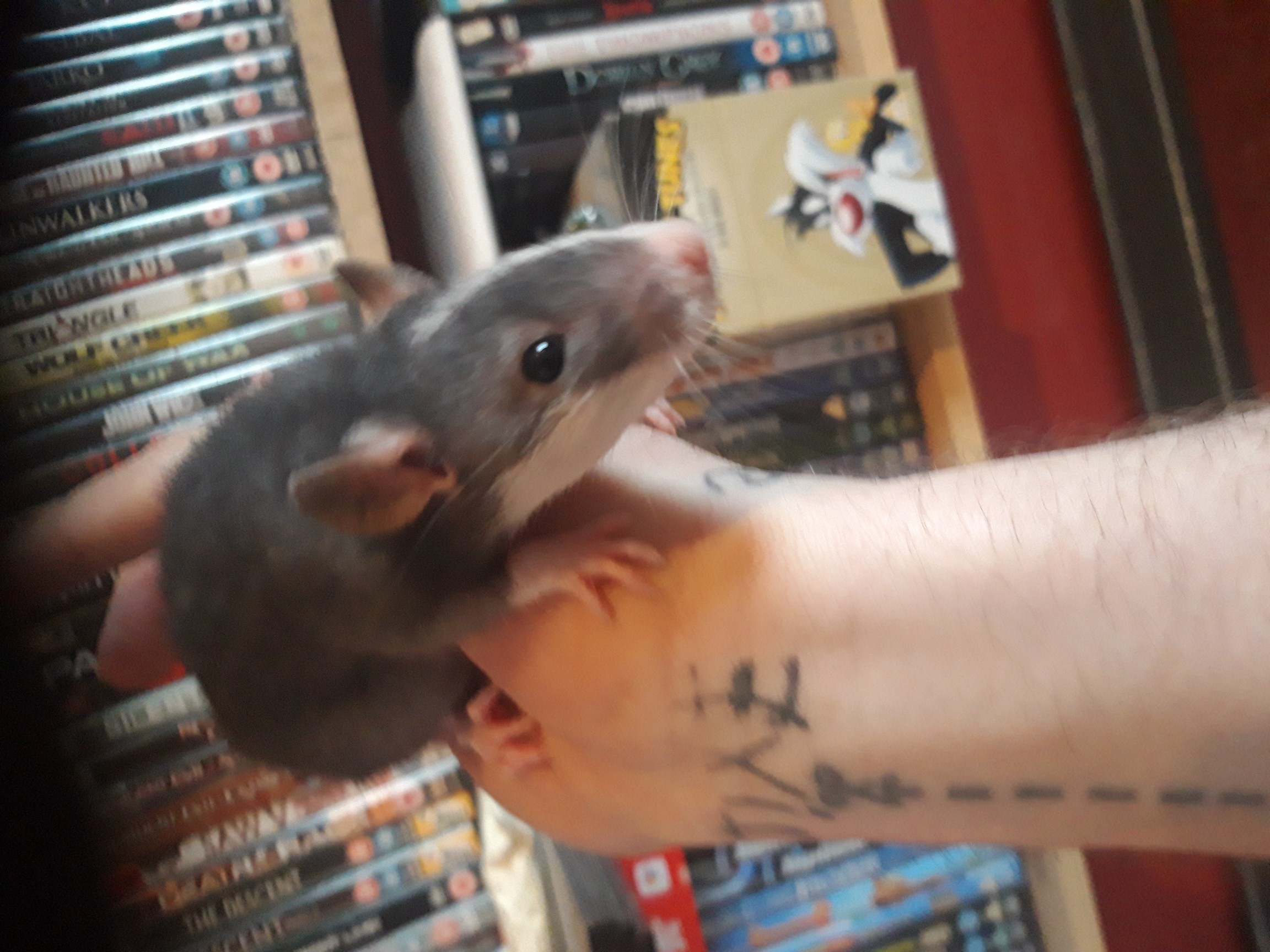Our rats are not pet shop animals, they are all heavily, pedigreed and shipped in from the healthiest lines we could find. We have bred our current lines for 45 or more generations ourselves. And they have 25 + years of pedigree and healthy breeding behind our 40 generations of breeding's. We have some of the oldest and most established lines in the USA. We can verify the health of every rat in our pedigrees. Camarattery is very meticulous about record keeping.
We expect the same from the breeders we adopt from. Camarattery rats are bred for health, longevity and temperament. Most of our rats live from 3-4 years which is easily verifiable. It takes us weeks or months of planning before I place each pair together so I can be sure of the best outcome. We do want to make it clear that Camarattery is not a feeder breeder nor do we sell rats to or from feeder breeders.
There are plenty of feeder breeders in Colorado and they make it very hard for you to tell if they are a feeder breeder or a quality pet rat breeder. We are strictly a quality pedigreed pet rat breeder working on lines who are proven for longevity and mellow dispositions. Very social & engaging - generally very gregarious.
It is sometimes difficult to introduce new rats to each other, so it is best to purchase them at the same time from the same cage at the pet store. Rats are extremely intelligent and enjoy being handled and exploring. Your rat will love its out of cage time to play with you. Male rats do not often get along well together unless they are siblings and purchased at the same time; also make sure to select a cage large enough to give them separate living spaces.
Do not keep males and females together as they reproduce readily. Rats are easily tamed, even if they are difficult at first. The more you handle and work with your pet, the tamer it will become. Any animal may bite in defense if it feels threatened, but domestic rats generally are not known to bite. Remember to work with your pet after dusk, as it will be more willing to cooperate since it is a nocturnal animal.
Place your pet's cage in a place in the home where it will be around the family, yet protected from direct light, drafts and excess noise during the day. Also be sure it is high enough to be out of reach of dog noses and small children's hands. Rats are prey animals and can feel threatened by large bodies above them or in their faces. Most people don't know this, but rats typically live only two to three years.
Also, keep in mind many rats start to develop common medical problems after even just one year of life. So if you're considering having a rat as a pet, realize that your little buddy may not be around as long as a dog or cat. You can make the best of it, though, by making sure your pet rodent gets optimal care, including regular veterinary attention . Good everyday care for your pet rat would include things like having its bedding spot-cleaned daily and completely changed weekly.
Rats should be fed a base diet of pellets specifically formulated for rats, plus clean water and a small amount of table food . They also need exercise — running in smooth-sided toy wheels that can be placed in their cages and by having regular out-of-cage time as well. Double rex rats have two rex genes which results in a hairless rat rather than one with a kinky rex coat. These rats do have eyebrows and short, kinky or curly whiskers. You may see small patches of peach fuzz-like hair on their head or feet. These rats can also come in different colors, though the coloring will show up on their skin, much like a hairless cat's coat color.
Double rex rats can come in just about every color and ear type and may have black or red eyes. While they may appear the same at first glance, there are actually three different types of hairless rat pets with different genetic backgrounds. Aside from their unusual coat, these rats tend to be a bit smaller than other common fancy rats. Some owners consider them to be hypoallergenic because of their lack of hair, which is not the case, but people with allergies may find them more tolerable than furry rats.
As a professional breeder, Camarattery is always determined to provide the highest quality experience for our wonderful adopters. We are there for our adopters throughout the entire life of the rats they adopt from us. We do not breed or keep rats for a profit, and do not breed in dingy conditions. Everything we do is with the highest respect for the animals we care for.
From the caging, toys and food we feed, to the respect shown to them and with the high quality photos taken. I have pictures in National Geographic as well as Cengage Learning publications to prove my insistence of quality and excellence. So when you adopt from us you know that every facet of care we give these animals is the best you can get. We don't play around with a hobby in the backyard, these animals are in pristine conditions in our home, eating the organic foods we eat, every day, and getting love from us daily. Their cages are cleaned and sanitized every other day. My rats make me happy, I could not do it without them.
They can be found through pet stores that sell small animals, as well as through specialty rat fancy breeders. The American Fancy Rat & Mouse Association website lists local rat clubs and shows where you can find breeders of specialty rats. You can also check the Petfinder and Adopt-a-Pet websites to see if shelters near you have hairless rats available for adoption. Much less commonly found in the pet fancy is the Sphynx rat, which gets its name from the hairless cat breed. These rats are bred to have no hair at all, which includes having no whiskers or eyebrows. Usually these rats are bred specifically to be used in labs for research and not as pets.
These rats tend to live about half the lifespan of a normal rat. They suffer from respiratory, bacterial, kidney and liver diseases due to their genetic makeup, which involves congenital deficiencies in their immune system. They were bred specifically as hunting cats, helping silk factories keep the mouse population at bay. Like several other cat breeds throughout history, the Japanese Bobtail was considered a sacred animal back home.
Modern cat owners appreciate this feline breed because it's good company for adults and children alike. My babies are very friendly & have been handled since birth. They are very different from 'pet store' rats (which are usually just big feeders., they almost always come from a facility, not a breeder as most would assume). They take food from hands & will not poop or pee on you or squeak when picked up because they are comfortable with people & not scared. They enjoy coming out, being held & will sit calmly in your hand or pocket with the favourite place being your shoulder. I have past customer I available, many repeat customers & a testimonial page where you can see some pictures of my ratties happy in their new homes with their new families.
We breed because we love, love, love what we do, our job is to bring love into people's homes. Raising babies wonderful positive way to live our life. Rats are fantastic little kids and we love to share that with others.
They are smart, clean, can learn tricks like a dog, yet litter train like a cat. We love the antics of the rat as they are such little hams. They get so excited to see you and wrestle, play and bounce around when you come to their cage. Adopters are fun, the rats are adorable and I love the "camaraderie". Hairless rats are definitely adorable, smart pets that make amazing cuddlers. If you decide to take one home, make sure you take into consideration their special care needs compared to a "regular" rat with fur.
You also will need to understand that it's best to keep at least two as a hairless rat will need a companion to snuggle with even more than a regular rat will. Otherwise, once you're ready to handle their skin and health concerns, hairless rats can be loving, engaging companions with a unique look. The patchwork hairless rat also is the result of having two rex genes. These rats get their name from the curly or fuzzy hair that appears either all over their body or in a small patch or patches.
These rats tend to shed hair often as they grow older, but it does grow back, sometimes in the same spots and other times in new ones. Patchwork hairless rats also can be found in every color, ear type and eye color. Please note that Camarattery is not a pet store that adopts to everyone that asks for rats. Since we're a small breeder this affords us the ability to be very picky about who adopts rats. Furthermore, we rigorously screen each adopter and heavily contract each and every one of them. This way we know our rats will be cared for in a respectful and ethical manner.
Because of this we do turn down a few potential adopters, if things just don't seem right in our eyes. Our adopters need to show they care enough about us and our ethics before we adopt to them, its as simple as that. This can be something as simple as reading our adoption contract before they apply for rats and agreeing to the terms. Most adoptions that are denied are because of this.
All of our adopters are appreciated and we couldn't breed without them, but we do breed for "us" and to reach our own goals. We just cannot however keep all the babies produced, which is where you can benefit from our breeding's. Black Tan Frizzie kitten mouse owned and bred by Norah Hobgood. Photo ©2009 Karen Robbins.FRIZZIE SATIN - Frizzie Satin mice may be shown in any recognized color or markings.
The coat should be tightly waved or frizzed over the entire body as with the Frizzie, and should also have the distinctive satin sheen. Other cat owners choose the domesticated cat for an altogether different purpose. These people appreciate cats for theirnatural gifts, namely, their hunting instincts.
Cats have walked alongside human beings since time immemorial as valued assets for controlling the rodent population. On farms, in port cities and even on the decks of ships, cats have proven themselves worthy business partners for thousands and thousands of years. Rats, like dogs, cats and people, can often develop commonly encountered medical problems, such as breast tumors, respiratory tract disease and uterine infections.
Some of these conditions can be avoided altogether , while others can be treated if caught early . To prevent or treat disease, rats must have regular checkups with a rat-savvy veterinarian. Unfortunately, many rat owners either do not bring their pets to the vet for preventive checkups or wait until it's too late to bring their pets in when they are ill. There are many types of rats –Getting a rat at a pet store will likely yield you a standard rat — not a bad thing, but definitely not unique.
Breeders breed a variety of different rats that come in a variety of colors, shapes, and sizes. This allows you to find the exact type of rat that you want. Take a look at the AFRMA's description of rat varieties for a great overview of what's out there. Fancy rats, lab rats, and most "wild" rats that thrive alongside human societies are all of the same species, Rattus norvegicus.
What sets fancy rats apart is the fact that they have been bred over many generations for their good looks and pleasant natures. This has resulted in beautiful animals who truly enjoy contact with people. They seldom bite and are less likely to carry diseases that can be transmitted to people than are many other species of pets.
Rat adoption is a wonderful way to provide a Rat a second chance and caring environment. Most pets arrive at shelters because the owner had to move, could no longer afford the pet, had a death in the family, or simply gave up the responsibly of being a care taker for a Rat. Before bringing home a Rat, make sure you have considered the full impact of your decision. Below is a brief overview of the type of needs a Rat might require and what you will need to consider for the life time care of a Rat. Like all rats, hairless rats need daily enrichment to keep them happy and healthy. Just make sure that you clean them regularly and avoid any toys that might have sharp edges.
They also will need time out of the cage to spend time with you, and this should always be supervised time. Hairless rats also require bedding that is soft and will keep them warm. Bedding made up of wood shavings and chips will be uncomfortable for them and can damage their skin. They can do well with paper bedding like Carefresh if you change it daily as it can irritate their skin once soiled with urine. A good option for hairless rat bedding are shredded pieces of fleece or ripped up t-shirts and cotton products like towels.
You will need to be diligent about cleaning their bedding daily as their skin can get quickly irritated from urine and feces in the cage. Pet rat lovers may not be as familiar with the hairless rat as they are with their furry counterparts. These rats share many of the same wonderful characteristics as other fancy rats, though they do need some additional care and maintenance. Photo ©1984 AFRMA.FRIZZIE - Frizzie mice may be shown in any recognized color or markings. The coat should be tightly waved or frizzed over the entire body, very dense, with guard hairs of somewhat harsh texture, protruding slightly beyond the normal length of coat.
This is more pronounced in young mice, and should not influence the placement. Pink-Eyed White Long Hair mouse owned by Nichole Royer. Photo ©1996 Craig Robbins.LONG HAIR SATIN - Long Hair Satin mice may be shown in any recognized color or markings. The coat should be as long as possible, but combined with density, and is to have the distinctive sheen of the satin. Pink-Eyed White Standard mice owned and bred by Nancy Ferris.
Photo ©1997 Craig Robbins.SATIN - Satin mice may be shown in any recognized color or markings. The ideal coat has a unique and distinct appearance with its lustrous sheen. The hair should be very fine, dense, soft, and silky to the touch. We continue our world tour of cat breeds with the Turkish Angora, which hails from the nation of Turkey.




























